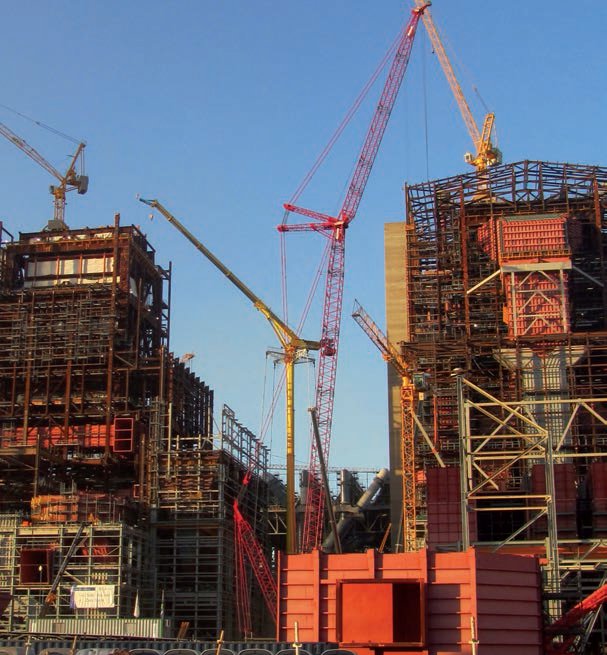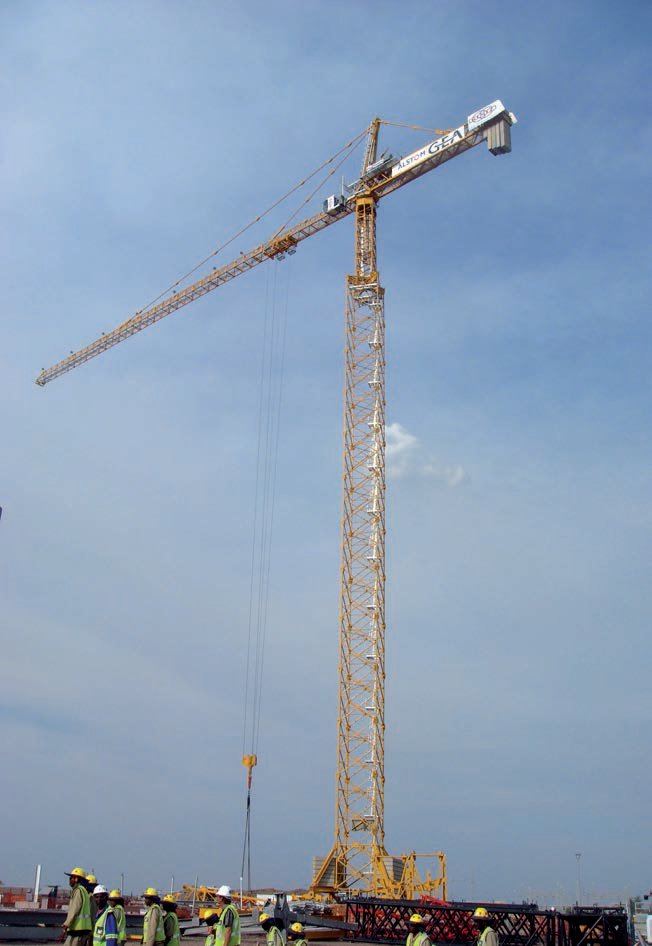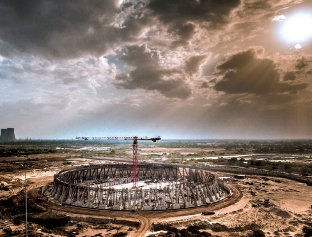Tower of power
13 November 2014Soaring demand for electricity around the world, particularly in emerging markets, is prompting a boom in power plant construction. As prefabricated concrete sections and other components get bigger, to allow for faster construction, so does the need for high capacity tower cranes. Steve Powney reports
You only have to look at the forecasts of planned power station projects around the world to see that tower crane manufacturers will have a busy time keeping up with the work. According to the World Resources Institute (WRI) more than 1,000 coal-fired power plants are in the planning, with the lion's share in China and India, each of which have hundreds in the pipeline.
The most recent data from the International Energy Agency shows China, the US and India are the three largest coal-fired electricity producers, while for natural gas it is the US, Russian Federation and Japan. In the nuclear electricity generation sector the US, France and Russian Federation are the largest.
But the trend is clear -- China and the rest of Asia are increasing their power usage dramatically, while the Middle East, non-OECD Americas and Africa are also growing, all at the expense of the OECD region market share.
China has seen a recent slowdown in fossil-fuel power plant new capacity due to economic slowdown, air pollution controls and the growth of non-fossil fuel energy generation.
But China's need to secure future base load capacity has had analysts predict a return to higher growth levels in coal-fired capacity in 2014 and 2015 -- with estimated capacity additions of 36GW in 2014, 42GW in 2015, 45GW in 2016 and 47GW in 2017.
Against this backdrop is even faster growth in renewable energy, so coal's share of the energy mix in China is expected to fall to 67% in 2020, with nuclear tripling its share to 6%.
In China, the Shanghai Electric Power Company (SEPC) has been involved in some large projects in recent years.
SEPC currently has seven MK2500 Favelle Favco tower cranes, featuring a maximum lifting capacity of 140t, radius of 64m and height of 132m.
The company says the most common size of coal-fired power station in China is for 1000MW, with the main chimney height commonly around 120m high. The plant's main beam weight is usually about 110t, with the main pillar weighing around 90t.
Its most recent project -- this year -- is phase 1 of the Pingshan Power Station, comprising 2x660MW power units. The main frame beam lifted was 130t to a height of 107m at a 11m radius.
Installation of the furnace -- an Ultra supercritical once-through pressure boiler unit -- typically takes about 4.5 months.
Elsewhere, the Middle East is seeing its fair share of projects, with Jordan recently announcing a US$10bn deal with the Russian state energy provider Rosatom Corporation to build and operate the country's first nuclear power plant; the United Arab Emirates has plans to build four reactors with a combined 5,600MW capacity by 2020, and Egypt has a 1,000MW reactor on its books.
In South Africa, a US$10bn deal for a new 9.6GW nuclear power plant has been signed to help solve the country's ongoing energy crises, while power utility Eskom is working on the new Medupi and Kusile coal-fired plants with a combined capacity of about 9,500MW.
And the UK's first new nuclear power station in a generation -- Hinkley Point C -- will involve more than 50 tower cranes for the main civil engineering part of the project.
In India, Zoomlion ElectroMech India Pvt. Ltd (ZEIPL) has supplied two high-end fiat-top tower cranes to Hyderabad-based Nagarjuna Construction Company (NCC) for construction of one of India's largest cooling towers at a coalbased thermal power project at Nellore in Andhra Pradesh. The 20t capacity TCT7527- 20 cranes, designed for cooling tower applications, with a tip load of 2.7MT at the 75m jib end (or 3.2MT at the 70m jib end), have several innovative features such as VFD motion in all drives, provision of soft anchoring (sling support), enhanced drum capacity, localised 415V 50Hz power connection, anemometer, jib & counter jib dismantling device and double trolley automatic reeving change system. They also feature an anti-corrosion coating scheme developed by Zoomlion to endure hostile conditions at a thermal power plant site.
Zoomlion said the cranes' biggest advantage they offer is the ability to self-dismantle one section at a time once the cooling tower construction has been completed.
This is very important, Zoomlion added, considering the fact that a 75m jib needs to be dismantled, whereas the top opening of the cooling tower in which the crane will be standing is 78m in diameter.
Tushar Mehendale, ZEIPL's managing director, said: "The Indian infrastructure construction market has been expressing great interest in heavy capacity tower cranes of late with renewed focus on infrastructure development."
To support NCC in this project, ZEIPL has provided on-site training along with a consumables spare stock to guarantee crane performance and develop customer specialty.
Manitowoc's tower cranes division Potain is reporting power plant projects in Malaysia, Saudi Arabia, France and South Korea.
Pascal Ducrot, lift solutions manager at Potain, said in Malaysia a 40t Potain MD1100 is working for Chunjo, while the same model is being operated in Saudi Arabia by Potain agent NFT Crane and in Russia two units are in use by contractor Titan. In France, an MD 3200 and an MD 550 are working on a power plant in Flamanville alongside several smaller Potain cranes.
At power plant job sites, Potain tends to supply tower cranes with 25-40 t capacities and 60-80 m jibs. These relatively large size tower cranes give users the reach and lift ability to cover a large area of the site. Height under hook varies dramatically dependent on the project, but is typically from 50m to more than 120m.
Ducrot said: "Adaptability is our main asset. We provide off-theshelf cranes for many job sites around the world but the most demanding power plant projects require a bespoke solution. We design our largest tower cranes with a specific project in mind. This customised, tailor-made approach gives users the exact crane matched to their needs."
One of the southern hemisphere's largest power projects -- the US$12bn Medupi Power Station in South Africa's northernmost province of Limpopo -- is using three Potain tower cranes.
When complete, the coal-fired power station will employ six boilers each powering an 800 MW turbine. With its combined output of 4,800 MW, it is the largest dry-cooled coal power plant in the world.
The first cranes began preparation in 2008 and the last arrived on site this year. It is expected most will remain on the project until completion, scheduled for 2015. Kentz and SA French provided the tower cranes and the project is run under principal contractor Hitachi.
Two smaller Potain tower cranes, a 6t capacity MDT 98 and an 8t capacity MDT 178, are lifting structural steel elements for the bag filters, while the larger MD 1100 special application crane is erecting the air-cooled condenser's structure, plus the fans and fan rings on it.
Quentin van Breda, CEO of SA French, said the tower crane choice for the project was based on space and capacity.
He said: "Kentz used the MD 1100 because it has the capacity and reach to make the heavier lifts, so it was essential to have that crane," he said. "Similarly, because we had only limited space to work with the other cranes, we needed the MDT so we could handle the work on the bag filters. "The MDT cranes are easier to have working in closer proximity because of their topless design, and they're easier to assemble because of their modular design. This was useful as ground space and access was limited at the site." The MDTs are also taking up only a small area on the job, each sitting on a base of just 4.6m x 4.6m.
Liebherr has also been working at Medupi -- which will be the world's fourth-largest power plant. Ten Liebherr top-slewing EC-B and EC-H series tower cranes with capacities from 132t-280t are at work on this project. Two top-slewing cranes from Liebherr- Africa (Pty) Ltd with working radii of 40m and hook heights of 124m have been erected at the 120m+ high lift shafts.
To reach this enormous hook height, the tower cranes are tied-in to the lift shafts two times each. Most of the EC-H and EC-B cranes are used on the construction of the dry cooling. These cranes are equipped with a rail-going undercarriage so that they can cover a larger working range.
A total of six power station blocks at Medupi will be completed and connected to the electricity network by the end of 2016.



